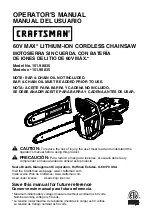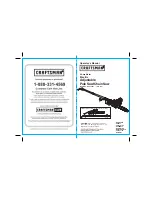
MAINTENANCE AND REPAIR INSTRUCTIONS
CHAIN MAINTENANCE
For smooth and fast cutting, the chain needs to be maintained properly.
The following conditions indicate that the chain requires sharpening:
• Wood chips are small and powdery.
• The chain must be forced through the wood during cutting.
• The chain cuts to one side.
During maintenance of the chain, consider the following:
• The depth gauge (or raker clearance) setting determines the height
at which the cutter enters the wood and the size of the wood chip
that is removed (Fig. 40). Too much clearance increases the
potential for kickback. Too little clearance decreases the size of
the wood chip, thus decreasing the chain's cutting ability.
• If the cutter teeth have hit hard objects, such as nails and stones,
or were abraded by mud or sand on the wood, have a service
dealer sharpen the chain.
NOTE:
Inspect the drive sprocket for wear or damage when
replacing the chain. If signs of wear or damage are present
in the areas indicated, have the drive sprocket replaced by
an authorized service center.
NOTE:
If you do not fully understand the correct procedure for
sharpening the cutters after reading the instructions that
follow, have the saw chain sharpened by an authorized
service center or replace the chain with a recommended
low-kickback chain.
SHARPENING THE CUTTERS
Be careful to file all cutters to the specified angles and to the same
length. Fast cutting can be obtained only when all cutters are uniform.
• Tighten the chain tension enough so that the chain does not
wobble. Do all of the filing at the midpoint of the guide bar. Wear
gloves for protection.
• Use a 3/16” round file and holder.
• Keep the file level with the top plate of the tooth (Fig. 41). Do not
let the file dip or rock (Fig. 42).
• Using light but firm pressure, stroke towards the front corner of the
tooth (Fig. 42). Lift the file away from the cutter before returning
the file to the beginning of the sharpening stroke.
• Put a few firm strokes on every tooth. File all left hand cutters in
one direction (Fig. 43). Then move to the other side and file the
right hand cutters in the opposite direction (Fig. 43). Occasionally
remove filings from the file with a wire brush.
Top Plate Filing Angle
• CORRECT (30°) – File holders are marked with guide marks to align
the file properly and produce the correct top plate angle (Fig. 44).
• INCORRECT (LESS THAN 30°) – For cross cutting (Fig. 45).
• INCORRECT (MORE THAN 30°) – This creates a feathered edge
that dulls quickly.
Side Plate Filing Angle
• CORRECT (80°) – This is produced automatically if the correct
diameter file is used in the file holder (Fig. 44).
• INCORRECT (HOOK) – This causes the chain to “grab” and dull
quickly, increasing the potential for kickback. A hook is caused by
using a file with too small a diameter or a file held too low (Fig. 45).
• INCORRECT (BACKWARD SLOPE) – This causes a need for too
much feed pressure, producing excessive wear to the guide bar
and chain. A backward slope is caused by using a file with too
large a diameter or a file held too high.
MAINTAINING DEPTH GAUGE CLEARANCE
• Maintain the depth gauge at a clearance of 1/32" (0.6 mm). Use a
depth gauge tool for checking the depth gauge clearances. (Fig. 40)
• Every time the chain is filed, check the depth gauge clearance.
• Use a flat file and a depth gauge jointer to lower all gauges
uniformly (Fig. 46). Use a 1/32 inch (0.6 mm) depth gauge jointer.
After lowering each depth gauge, restore the original shape by
rounding the front (Fig. 47). Be careful not to damage adjoining
drive links with the edge of the file.
• Depth gauges must be adjusted with the flat file in the same
direction the adjoining cutter was filed with the round file.
• Use care not to contact the cutter face with the flat file when
adjusting depth gauges.
Top Plate
Fig. 40
Gullet
Fig. 41
Fig. 42
Left Hand
Cutters
Fig. 43
Right Hand
Cutters
Raker Clearance
1/32” (0.6 mm)
Fig. 46
Cutting Corner
Depth
Gauge
Side Plate
Fig. 47
WARNING:
A dull or improperly sharpened chain
can cause excessive engine speed during cutting,
which may result in severe engine damage.
WARNING:
Improper chain sharpening increases
the potential of kickback. Failure to replace or repair a
damaged chain can cause serious injury.
Flat File
Depth Gauge Jointer
Restore Original
Shape by Rounding
the Front
Filing Height
Filing Angle
Fig. 44
Top Plate
30˚
80˚
Correct
Filing Angles
Side Plate
Fig. 45
Less Than 30˚
More Than 30˚
Incorrect
Filing Angles
Hook
Backward Slope
Top Plate
Side Plate
MAINTAINING THE GUIDE BAR
To minimize guide bar wear, the following maintenance procedures
are recommended:
• Rotate the guide bar frequently at regular intervals (for example,
after every 5 hours of operation), to ensure even wear on the top
and bottom of the guide bar (Fig. 48).
• Clean the guide bar groove and oil passages whenever the saw chain
is removed, when the unit has been used heavily or when the saw
chain appears dirty (Fig. 49). Oil passages can be cleaned with a soft
wire small enough to insert into the oil discharge hole (Fig. 49).
NOTE:
If the oil passages are clear, the saw chain will give off a
spray of oil within seconds of starting the unit.
Frequently check the guide bar for damage. Feathering and burring of
the guide bar rails (the ridges on either side of the bar groove) is a
normal process of guide bar wear. Such faults should be smoothed
with a file as soon as they occur.
A guide bar with the following faults should be replaced:
• Wear inside the guide bar rails that permits the chain to lay sideways.
• Bent guide bar.
• Cracked or broken rails.
• Spread rails.
Lubricating the Guide Bar Sprocket Tip
NOTE:
It is not necessary to remove the saw chain to lubricate the
guide bar sprocket tip.
1. Clean the guide bar sprocket tip.
2. Insert the tip of the Lube Gun (not included) into the lubrication
hole and inject grease until it appears at the outer edge of the
guide bar sprocket tip (Fig. 50).
NOTE:
The Lube Gun is recommended for applying grease to the
guide bar sprocket tip. The Lube Gun is equipped with a
needle nose tip, which is necessary for the efficient
application of grease to the guide bar sprocket tip.
3. Rotate the saw chain by hand. Repeat the lubrication procedure
until the entire guide bar sprocket tip is greased.
CLEANING THE AIR FILTER
1. Remove the air filter cover by loosening the cover-retaining
screws (Fig. 51). The cover will lift off.
2. Remove the air filter.
3. Wash the air filter in clean, warm, soapy water. Rinse the air filter
in clean, cool water. Allow the filter to air dry completely.
NOTE:
It is advisable to have a supply of spare air filters.
4. Install the air filter and replace the air filter cover. Make sure the
air filter cover fits properly. Tighten the cover-retaining screws
securely.
REPLACING THE FUEL FILTER
1. Remove the fuel tank cap.
2. Pull the fuel filter out of the fuel tank with a bent wire or long
needle-nosed pliers (Fig. 52). Disconnect and discard the fuel filter.
NOTE:
Do not pull the hose completely out of the fuel tank.
3. Install a new fuel filter onto the hose. Push the hose and fuel filter assembly back into the fuel tank so that the fuel
filter is positioned in the right front corner.
4. Fill the fuel tank with fresh fuel/oil mixture. Refer to
Oil and Fuel Information
. Replace the fuel tank cap.
CLEANING THE SPARK ARRESTOR SCREEN
NOTE:
A clogged spark arrestor screen will dramatically reduce
engine performance.
1. Locate the muffler assembly at the front of the unit. Use a T27 Torx
wrench to remove the two muffler-retaining screws (Fig. 53).
2. Remove the muffler assembly and gasket from the unit.
3. Use the multi-purpose tool to remove the deflector-retaining screw.
4. Remove the outer deflector and spark arrestor screen.
5. Use a small wire brush to remove debris from the spark arrestor
screen.
6. Reconnect the spark arrestor screen and outer deflector to the
muffler assembly. Make sure the two tabs on the outer deflector
are inserted into the two slots on the muffler assembly. Tighten
the deflector-retaining screw securely.
7. Insert the two muffler-retaining screws into the muffler assembly. Place the gasket behind the muffler assembly so
that the two muffler-retaining screws pass through the two holes in the gasket. Make sure the narrow end of the
gasket faces the bottom of the muffler assembly (Fig. 53). Insert the muffler assembly and gasket into the cavity at
the front of the unit so that the screws align with the two screw holes in the front cavity. Tighten the muffler-
retaining screws securely to a torque of 80-90 in.lbs. If necessary, hold the gasket from the side with a pair of
needle-nose pliers while tightening the screws. If assistance is required for achieving the proper torque, have the
unit serviced by an authorized service dealer.
INSPECTING/ADJUSTING/REPLACING THE SPARK PLUG
NOTE:
For efficient operation, the spark plug must be kept clean
and properly gapped.
1. Push the stop switch up to the STOP position.
2. Use the multi-purpose tool to remove the two retaining screws
from the top plate (Fig. 54). Remove the top plate.
3. Disconnect the wire connector from the spark plug by pulling and
twisting at the same time (Fig. 54).
4. Remove the spark plug with a spark plug socket wrench. DO NOT USE ANY OTHER TOOL.
5. Check the electrode gaps with a wire feeler gauge. The gap should be set to 0.025 in. (0.635 mm). Adjust the gaps
if necessary.
6. Reinstall the correctly gapped spark plug or, if needed, install a new spark plug (Champion RDJ8J or equivalent).
NOTE:
A resistor spark plug must be used for replacement (part number 753-06269 or Champion RDJ8J).
CARBURETOR ADJUSTMENT
The carburetor was pre-set at the factory for optimum performance. If further adjustments are necessary, please have
the unit serviced by an authorized service dealer.
MAINTENANCE AND REPAIR INSTRUCTIONS
Fig. 48
CAUTION:
Never operate the unit without the air
filter. Dust and dirt will be drawn into the engine and
damage it. Keep the air filter clean.
CAUTION:
Never operate the unit without the fuel
filter. The fuel filter should be replaced after every 20
hours of use. Drain the fuel tank before replacing the
fuel filter.
Fig. 51
Fig. 52
Fig. 53
Fig. 54
WARNING:
Do not sand blast, scrape or clean
spark plug electrodes. Dislodged grit could damage
the cylinder. Replace corroded spark plugs.
CAUTION:
The guide bar sprocket tip was pre-
lubricated at the factory. Lubrication of the guide bar
sprocket tip is recommended after every 10 hours of
operation or once per week, whichever comes first.
Always thoroughly clean the guide bar sprocket tip
before lubrication. Failure to lubricate the guide bar
sprocket tip as explained below will result in poor
performance and seizure, voiding the warranty.
Fig. 49
Fig. 50
Air Filter
Cover
Air Filter
Fuel
Tank Cap
Fuel Filter
Spark
Arrestor
Screen
Outer
Deflector
Muffler-retaining Screws
Muffler
Assembly
Top
Plate
Spark
Plug
Guide Bar
Groove
Oil
Passages
Deflector-retaining
Screw
Gasket
7








































